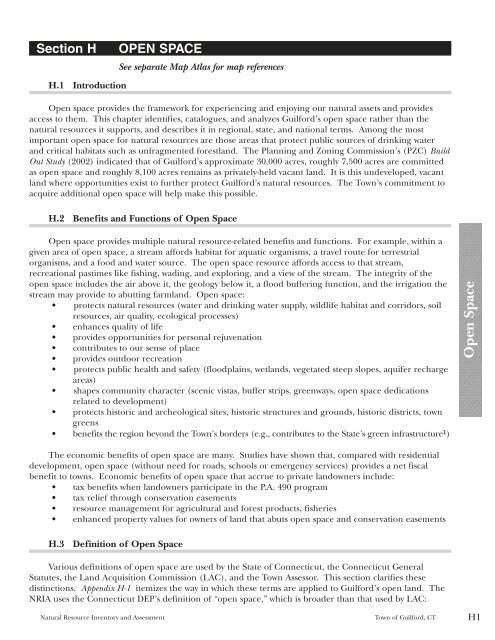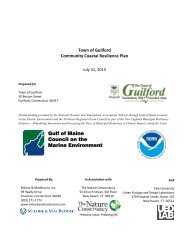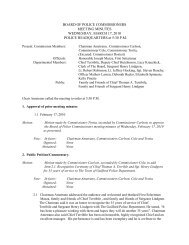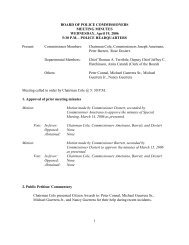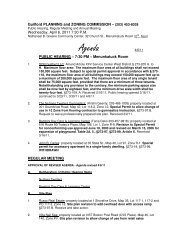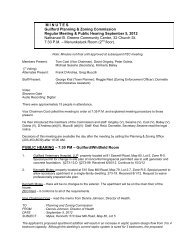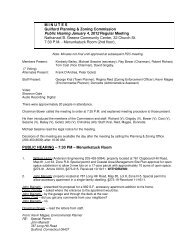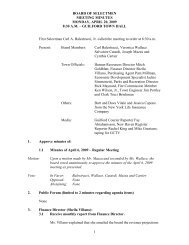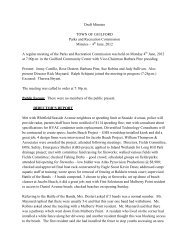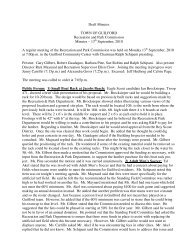Natural Resource Inventory and Assessment - Town of Guilford
Natural Resource Inventory and Assessment - Town of Guilford
Natural Resource Inventory and Assessment - Town of Guilford
You also want an ePaper? Increase the reach of your titles
YUMPU automatically turns print PDFs into web optimized ePapers that Google loves.
Section H OPEN SPACE<br />
H.1 Introduction<br />
See separate Map Atlas for map references<br />
Open space provides the framework for experiencing <strong>and</strong> enjoying our natural assets <strong>and</strong> provides<br />
access to them. This chapter identifies, catalogues, <strong>and</strong> analyzes <strong>Guilford</strong>’s open space rather than the<br />
natural resources it supports, <strong>and</strong> describes it in regional, state, <strong>and</strong> national terms. Among the most<br />
important open space for natural resources are those areas that protect public sources <strong>of</strong> drinking water<br />
<strong>and</strong> critical habitats such as unfragmented forestl<strong>and</strong>. The Planning <strong>and</strong> Zoning Commission’s (PZC) Build<br />
Out Study (2002) indicated that <strong>of</strong> <strong>Guilford</strong>’s approximate 30,000 acres, roughly 7,500 acres are committed<br />
as open space <strong>and</strong> roughly 8,100 acres remains as privately-held vacant l<strong>and</strong>. It is this undeveloped, vacant<br />
l<strong>and</strong> where opportunities exist to further protect <strong>Guilford</strong>’s natural resources. The <strong>Town</strong>’s commitment to<br />
acquire additional open space will help make this possible.<br />
H.2 Benefits <strong>and</strong> Functions <strong>of</strong> Open Space<br />
Open space provides multiple natural resource-related benefits <strong>and</strong> functions. For example, within a<br />
given area <strong>of</strong> open space, a stream affords habitat for aquatic organisms, a travel route for terrestrial<br />
organisms, <strong>and</strong> a food <strong>and</strong> water source. The open space resource affords access to that stream,<br />
recreational pastimes like fishing, wading, <strong>and</strong> exploring, <strong>and</strong> a view <strong>of</strong> the stream. The integrity <strong>of</strong> the<br />
open space includes the air above it, the geology below it, a flood buffering function, <strong>and</strong> the irrigation the<br />
stream may provide to abutting farml<strong>and</strong>. Open space:<br />
• protects natural resources (water <strong>and</strong> drinking water supply, wildlife habitat <strong>and</strong> corridors, soil<br />
resources, air quality, ecological processes)<br />
• enhances quality <strong>of</strong> life<br />
• provides opportunities for personal rejuvenation<br />
• contributes to our sense <strong>of</strong> place<br />
• provides outdoor recreation<br />
• protects public health <strong>and</strong> safety (floodplains, wetl<strong>and</strong>s, vegetated steep slopes, aquifer recharge<br />
areas)<br />
• shapes community character (scenic vistas, buffer strips, greenways, open space dedications<br />
related to development)<br />
• protects historic <strong>and</strong> archeological sites, historic structures <strong>and</strong> grounds, historic districts, town<br />
greens<br />
• benefits the region beyond the <strong>Town</strong>’s borders (e.g., contributes to the State’s green infrastructure 1)<br />
The economic benefits <strong>of</strong> open space are many. Studies have shown that, compared with residential<br />
development, open space (without need for roads, schools or emergency services) provides a net fiscal<br />
benefit to towns. Economic benefits <strong>of</strong> open space that accrue to private l<strong>and</strong>owners include:<br />
• tax benefits when l<strong>and</strong>owners participate in the P.A. 490 program<br />
• tax relief through conservation easements<br />
• resource management for agricultural <strong>and</strong> forest products, fisheries<br />
• enhanced property values for owners <strong>of</strong> l<strong>and</strong> that abuts open space <strong>and</strong> conservation easements<br />
H.3 Definition <strong>of</strong> Open Space<br />
Various definitions <strong>of</strong> open space are used by the State <strong>of</strong> Connecticut, the Connecticut General<br />
Statutes, the L<strong>and</strong> Acquisition Commission (LAC), <strong>and</strong> the <strong>Town</strong> Assessor. This section clarifies these<br />
distinctions. Appendix H-1 itemizes the way in which these terms are applied to <strong>Guilford</strong>’s open l<strong>and</strong>. The<br />
NRIA uses the Connecticut DEP’s definition <strong>of</strong> “open space,” which is broader than that used by LAC:<br />
<strong>Natural</strong> <strong>Resource</strong> <strong>Inventory</strong> <strong>and</strong> <strong>Assessment</strong> <strong>Town</strong> <strong>of</strong> <strong>Guilford</strong>, CT H1<br />
Open Space


